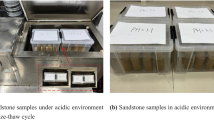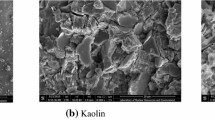Abstract
Underground rock is often subjected to the coupled action of acid sulfate, chloride ion corrosion, and external dynamic disturbance: the degree of corrosion and dynamic load can significantly affect the pore structure and mechanical behavior of rock. To quantify the microscopic pore structure changes and macro-dynamic behavior characteristics of acidified corroded sandstone, first, a mixed acidic solution of NaHSO4 and HCl with different pH values was used for immersion corrosion of sandstone; second, the pore structure of sandstone before and after corrosion was quantitatively evaluated by nuclear magnetic resonance (NMR), dynamic loading tests of corroded sandstone were conducted on an SHPB experimental system and scanning electron microscopy (SEM) was used to observe the morphology of corroded sandstone section; and finally, the mechanism of water–rock interaction and damage and fracture of acid-corroded sandstone were analyzed. The results show that, after acidizing corrosion of sandstone, the macropores increase significantly in number and volume, the boundary of the pore structure tends to be fuzzy; the effective porosity, the number of effective pores, and the total porosity increase significantly; the residual porosity, the number of residual pores, and T2 cut-off value decrease. The proportion accounted for by the elastic stage in stress–strain curves of corroded sandstone is lowered; the proportion accounted for by the plastic yield stage is increased; and post-peak rebound is diminished. With the decrease of pH value, the peak stress on acid-corroded sandstone decreases and the peak strain increases. The peak stress on corroded sandstone is negatively correlated with effective porosity and the number of effective pores, but positively correlated with residual porosity, the number of residual pores, and the T2 cut-off value. The reaction of acidic solution with sandstone minerals causes the free fluid space to increase, the bound fluid space decreases, and the number of pores increases, resulting in a decrease in the dynamic strength of acidified sandstone. The fracture of original sandstone after impact failure has no obvious directionality, and the failure mode of grain is the coexistence of intergranular fracture and trans-granular fracture. The fracture of sandstone after acidizing corrosion is obviously directional after impact damage, and the fracture form is single, which is intergranular fracture. The research results can provide a certain reference for the protection of rock engineering under acidic water chemical environment.
















Similar content being viewed by others
References
Bai HB, Ma D, Chen ZQ (2013) Mechanical behavior of groundwater seepage in karst collapse pillars. Eng Geol 164:101–106. https://doi.org/10.1016/j.enggeo.2013.07.003
Erguler ZA, Ulusay R (2009) Water-induced variations in mechanical properties of clay-bearing rocks. Int J Rock Mech Min 46:355–370. https://doi.org/10.1016/j.ijrmms.2008.07.002
Fang XY, Xu JY, Wang PX (2018) Compressive failure characteristics of yellow sandstone subjected to the coupling effects of chemical corrosion and repeated freezing and thawing. Eng Geol 233:160–171
Feng XT, Chen SL, Zhou H (2004a) Real-time computerized tomography (CT) experiments on sandstone damage evolution during triaxial compression with chemical corrosion. Int J Rock Mech Min 41:181–192. https://doi.org/10.1016/S1365-1609(03)00059-5
Feng X, Chen S, Zhou H (2004b) Real-time computerized tomography (CT) experiments on sandstone damage evolution during triaxial compression with chemical corrosion. Int J Rock Mech Min Sci 41(2):181–192
Feng X, Li S, Chen S (2004c) Efect of water chemical corrosion on strength and cracking characteristics of rocks. Key Eng Mater 261:1355–1360
Feng JJ, Wang EY, Shen RX, Chen L, Li XL, Xu ZY (2016) Investigation on energy dissipation and its mechanism of coal under dynamic loads. Geomech Eng 11:657–670. https://doi.org/10.12989/gae.2016.11.5.657
Gao F, Wang QL, Deng HW, Zhang J, Tian WG, Ke B (2017) Coupled effects of chemical environments and freeze-thaw cycles on damage characteristics of red sandstone. Bull Eng Geol Environ 76:1481–1490
Gong FQ, Li XB, Liu XL, ZHAO J (2010) Experimental study of dynamic characteristics of sandstone under one-dimensional coupled static and dynamic loads. Rock Soil Mech 24(5):817–821 (in Chinese)
Han TL, Chen YS, Shi JP, Yu C, He MM (2013) Experimental study of mechanical characteristics of sandstone subjected to hydrochemical erosion. Chinese J Rock Mech Eng 32(S2):3064–3072
Huang Z, Li XZ, Li SJ, Zhao K, Zhang R (2018) Investigation of the hydraulic properties of deep fractured rocks around underground excavations using high-pressure injection tests. Eng Geol 245:180–191
Huo RK, Qiu T, Liang YL, Li SG, Qian MT (2020) The physicomechanical deterioration characteristics and mesoscopic damage analysis of sandstone under acidic environment. Adv Civ Eng. https://doi.org/10.1155/2020/7467608
Ju JF, Xu JL, Fang ZY (2019) Water-rock interaction experiments with acidic aqueous solution and iron bearing broken rocks and characteristics of water permeability decline. J China Coal Soc 44(11):3388–3395
Kong XG, Wang EY, Li SG, Lin HF, Zhang ZB, Ju YQ (2020) Dynamic mechanical characteristics and fracture mechanism of gas-bearing coal based on SHPB experiments. Theor Appl Fract Mec 105:102395
Li F, Qiu JR (1990) Study on behavior of mineral matters in coal during burning process. J Eng Therm 20(2):258–260
Li GL, Wei LY, Su HJ, Jing HW, Zhang T (2018) Dynamic properties of corroded limestone based on SHPB. Chinese J Rock Mech Eng 37(09):2075–2083
Li HR, Shen RX, Wang EY, Li DX, Li TX, Chen TQ, Hou ZH (2020a) Effect of water on the time-frequency characteristics of electromagnetic radiation during sandstone deformation and fracturing. Eng Geol 265:105451
Li LP, Sun SQ, Wang J, Yang WM, Song SG, Fang ZD (2020b) Experimental study of the precursor information of the water inrush in shield tunnels due to the proximity of a water-filled cave. Int J Rock Mech Min 130:104320. https://doi.org/10.1016/j.ijrmms.2020.104320
Li SG, Wu YM, Huo RK, Song ZP, Fujii Y, Shen YJ (2020c) Mechanical properties of acid-corroded sandstone under uniaxial compression. Rock Mech Rock Eng 54(1):289–302
Li M, Wang DM, Shao ZL (2020d) Experimental study on changes of pore structure and mechanical properties of sandstone after high-temperature treatment using nuclear magnetic resonance. Eng Geol 275:105739
Lu ZD, Chen CX, Feng XT, Zhang YL (2014) Strength failure and crack coalescence behavior of sandstone containing single pre-cut fissure under coupled stress, fluid flow and changing chemical environment. J Cent South Univ 21:1176–1183
Lu YL, Wang LG, Sun XK, Wang J (2017) Experimental study of the influence of water and temperature on the mechanical behavior of mudstone and sandstone. Bull Eng Geol Environ 76:645–660
Miao SJ, Cai MF, Guo QF, Wang PT, Liang MC (2016) Damage effects and mechanisms in granite treated with acidic chemical solutions. Int J Rock Mech Min 88:77–86
Miao SJ, Wang H, Cai MF, Song YF, Ma JT (2018) Damage constitutive model and variables of cracked rock in a hydro-chemical environment. Arab J Geosci 11(2):1–14
Min KB, Rutqvist J, Elsworth D (2009) Chemically and mechanically mediated influences on the transport and mechanical characteristics of rock fractures. Int J Rock Mech Min 46:80–89
Mossmark F, Ericsson LO, Norin M, Dahlstrom LO (2015) Hydrochemical changes caused by underground constructions—a case study of the Kattleberg rail tunnel. Eng Geol 191:86–98
Peng K, Zhou JQ, Zou QL, Zhang J, Wu F (2019) Effects of stress lower limit during cyclic loading and unloading on deformation characteristics of sandstones. Constr Build Mater 217:202–215. https://doi.org/10.1016/j.conbuildmat.2019.04.183
Qin L, Zhai C, Xu J, Liu S, Zhong C, Yu G (2019) Evolution of the pore structure in coal subjected to freeze—thaw using liquid nitrogen to enhance coalbed methane extraction. J Petrol Sci Eng 175:129–139. https://doi.org/10.1016/j.petrol.2018.12.037
Roy DG, Singh TN, Kodikara J, Das R (2017) Effect of water saturation on the fracture and mechanical properties of sedimentary rocks. Rock Mech Rock Eng 50:2585–2600
Rusin Z, Swiercz P (2017) Frost resistance of rock materials. Constr Build Mater 148:704–714
Shen RX, Li HR, Wang EY, Chen TQ, Li TX, Tian H, Hou ZH (2020) Infrared radiation characteristics and fracture precursor information extraction of loaded sandstone samples with varying moisture contents. Int J Rock Mech Min 130:104344
Song KI, Cho GC, Chang SB (2012) Identification, remediation, and analysis of karst sinkholes in the longest railroad tunnel in South Korea. Eng Geol 135:92–105. https://doi.org/10.1016/j.enggeo.2012.02.018
Song F, Wang H, Jiang M (2018) Analytically-based simplified formulas for circular tunnels with two liners in viscoelastic rock under anisotropic initial stresses. Constr Build Mater 175:746–767
Sun Y, Zhai C, Xu JZ, Cong YZ, Qin L, Zhao C (2020) Characterisation and evolution of the full size range of pores and fractures in rocks under freeze-thaw conditions using nuclear magnetic resonance and three-dimensional X-ray microscopy. Eng Geol 271:105616. https://doi.org/10.1016/j.enggeo.2020.105616
Xie S, Yao Y, Chen JY, Yao W (2015) Research of micro-pore structure in coal reservoir using low-field NMR. J China Coal Soc 40:170–176
Xu JZ, Zhai C, Liu SM, Qin L, Wu SJ (2017) Pore variation of three different metamorphic coals by multiple freezing-thawing cycles of liquid CO2 injection for coalbed methane recovery. Fuel 208:41–51. https://doi.org/10.1016/j.fuel.2017.07.006
Xu JZ, Zhai C, Qin L, Wu SJ, Sun Y, Dong RW (2018) Characteristics of pores under the influence of cyclic cryogenic liquid carbon dioxide using low-field nuclear magnetic resonance. Geofluids. https://doi.org/10.1155/2018/1682125
Yao Y, Liu D, Che Y, Tang D, Tang S, Huang W (2010) Petrophysical characterization of coals by low-field nuclear magnetic resonance (NMR). Fuel 89:1371–1380. https://doi.org/10.1016/j.fuel.2009.11.005
Yu LY, Zhang ZQ, Wu JY, Liu RC, Qin H, Fan PX (2020) Experimental study on the dynamic fracture mechanical properties of limestone after chemical corrosion. Theor Appl Fract Mec 108:102620. https://doi.org/10.1016/j.tafmec.2020.102620
Yuan ZH (2015) Research on change mechanism of strength and microstructure of loess under wetting-drying cycle. Dissertation, Chang’an University
Zhai C, Qin L, Liu SM, Xu JZ, Tang ZQ, Wu SL (2016) Pore structure in coal: pore evolution after cryogenic freezing with cyclic liquid nitrogen injection and its implication on coalbed methane extraction. Energ Fuel 30:6009–6020
Zhang GH, Jiao YY, Ma CX, Wang H, Chen LB, Tang ZC (2018) Alteration characteristics of granite contact zone and treatment measures for inrush hazards during tunnel construction—a case study. Eng Geol 235:64–80
Zhou Z, Cai X, Chen L, Cao WH, Zhao Y, Xiong C (2017) Influence of cyclic wetting and drying on physical and dynamic compressive properties of sandstone. Eng Geol 220:1–12
Zhou KP, Liu TY, Hu ZX (2018a) Exploration of damage evolution in marble due to lateral unloading using nuclear magnetic resonance. Eng Geol 244:75–85
Zhou Z, Cai X, Ma D, Cao W, Chen L, Zhou J (2018b) Effects of water content on fracture and mechanical behavior of sandstone with a low clay mineral content. Eng Fract Mech 193:47–65. https://doi.org/10.1016/j.engfracmech.2018.02.028
Acknowledgements
This project is supported by the National Science Foundation for Young Scientists of Jiangsu Province (BK20180644), National Natural Science Foundation of China (52004267) and China Postdoctoral Science Foundation (2019M652021, 2020M672235).
Author information
Authors and Affiliations
Corresponding author
Ethics declarations
Conflict of interest
The authors declare that they have no conflict of interest.
Additional information
Publisher's Note
Springer Nature remains neutral with regard to jurisdictional claims in published maps and institutional affiliations.
Rights and permissions
About this article
Cite this article
Li, X., Liu, Z., Feng, X. et al. Effects of Acid Sulfate and Chloride Ion on the Pore Structure and Mechanical Properties of Sandstone Under Dynamic Loading. Rock Mech Rock Eng 54, 6105–6121 (2021). https://doi.org/10.1007/s00603-021-02612-x
Received:
Accepted:
Published:
Issue Date:
DOI: https://doi.org/10.1007/s00603-021-02612-x




